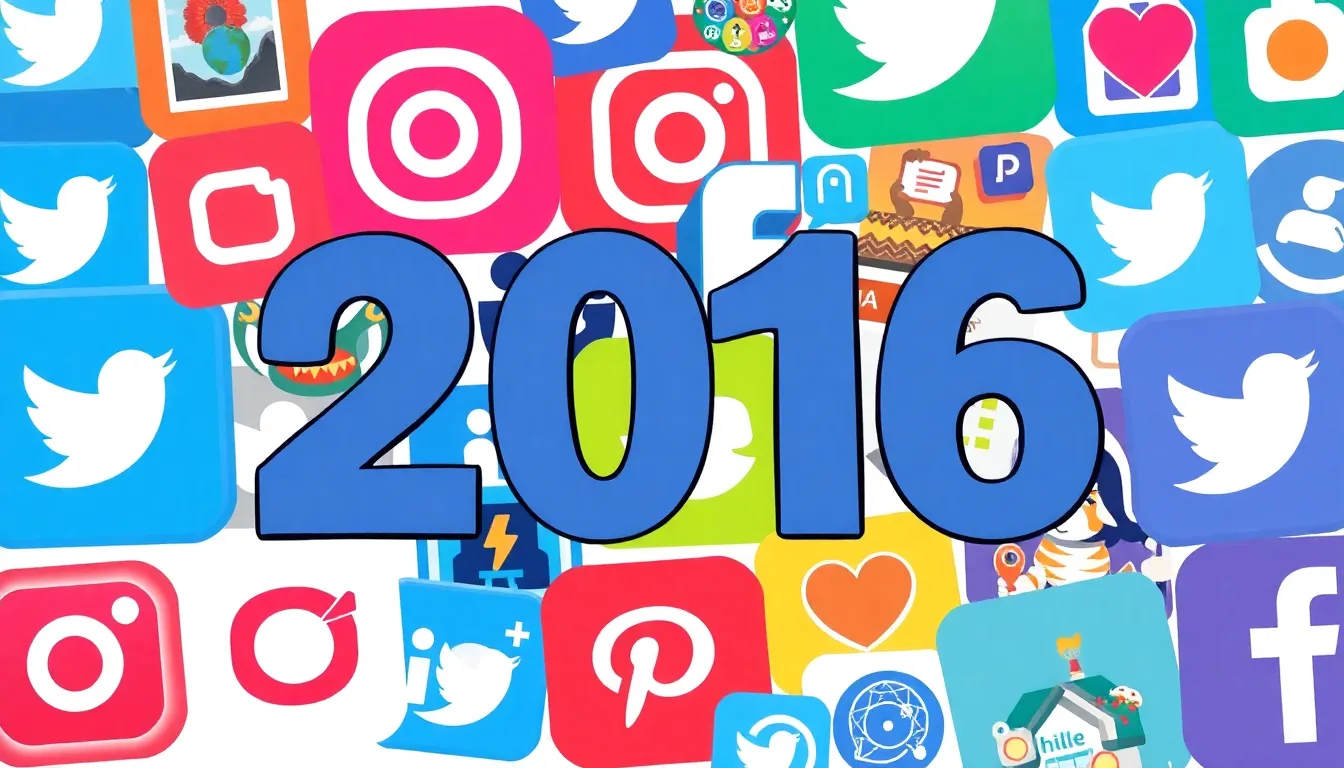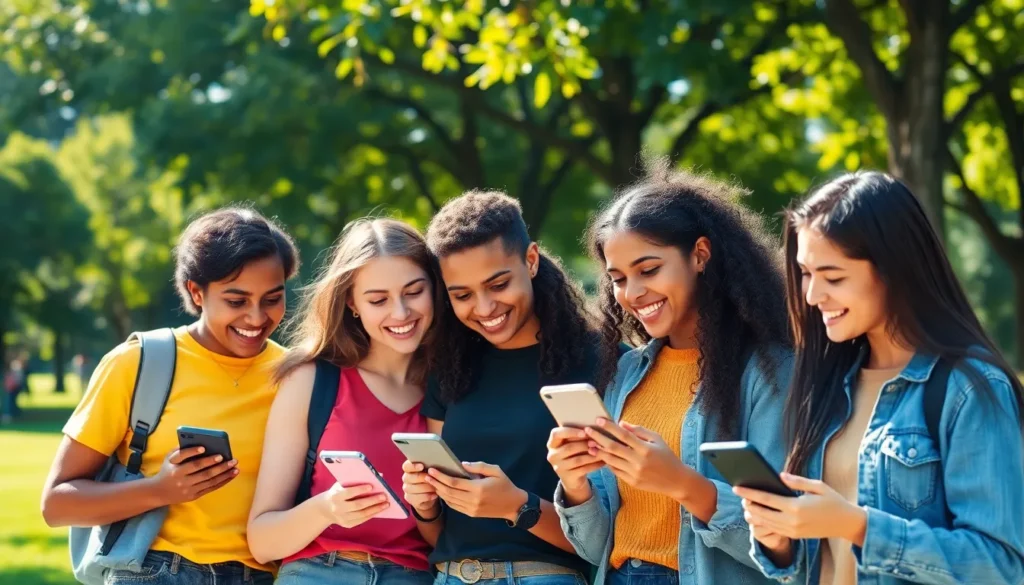In 2016, social media wasn’t just a pastime; it was a full-blown phenomenon that transformed the way people connected, shared, and even argued about cat videos. As platforms evolved, so did the trends that shaped online interactions, making the digital landscape more vibrant and chaotic than ever. From the rise of ephemeral content to the explosion of live streaming, it was a year where creativity and engagement took center stage.
Brands and influencers jumped on the bandwagon, embracing memes and hashtags like they were the latest fashion trend. With every scroll, users found themselves in a whirlwind of viral challenges and hashtag campaigns that kept them glued to their screens. Understanding these trends isn’t just for nostalgia; it’s essential for anyone looking to navigate today’s social media jungle with confidence and a dash of humor.
2016 Trends Social Media
2016 marked a pivotal year for social media, featuring trends that reshaped user interactions. Ephemeral content, known for its temporary nature, gained popularity through platforms like Snapchat. Users embraced the fleeting nature of posts, leading to increased engagement. Live streaming became a preferred tool, with Facebook Live and Instagram Live driving real-time connections.
Memes and hashtags emerged as powerful marketing tools. Brands leveraged trending memes to create relatable content, fostering community among users. Viral challenges, often spurred by hashtags, captivated audiences and encouraged participation. Engaging participants in these challenges generated buzz, heightening brand visibility.
Video content experienced surging popularity. Short-form videos attracted users’ attention, while longer, more produced content maintained its presence on platforms like YouTube. Marketers adapted strategies, focusing on storytelling to better connect with their audiences.
Mobile usage also surged significantly in 2016. As more users accessed social media on their mobile devices, brands optimized their content for mobile consumption. Emphasis on mobile-first strategies became crucial for maintaining engagement and capturing audiences on-the-go.
Analytics played a critical role in strategy refinement. Brands increasingly used data to inform their decisions, tailoring content to meet audience preferences. Measuring engagement rates and audience demographics provided valuable insights, allowing brands to adapt their approaches effectively.
These trends collectively influenced the social media landscape, promoting innovation in how brands connect with users. It’s essential to recognize these shifts and their impact on contemporary social media strategies.
Rise of Visual Content

Visual content gained immense traction in 2016, fundamentally altering how brands engage with audiences. Imagery and videos played a crucial role in capturing attention and conveying messages more effectively.
Importance of Imagery and Videos
Images and videos enhanced storytelling and boosted user engagement. Research indicated posts with visuals generate 94% more views than their text-only counterparts. Through vibrant visuals, brands articulated narratives that resonated more deeply with followers. This trend motivated businesses to invest in high-quality graphics and short videos to connect with audiences emotionally. Brands like Coca-Cola and Nike utilized compelling visual campaigns to amplify brand awareness, thereby facilitating stronger connections with consumers.
Memes and GIFs Dominating Engagement
Memes and GIFs surged in popularity, becoming central to social media interactions. Users often shared relatable memes, driving conversations and increasing engagement rates significantly. In 2016, platforms like Twitter and Facebook saw a marked rise in meme-related posts, enhancing user interaction. Content creators embraced these elements as tools for humor and relatability, allowing brands to humanize their messaging. Brands such as Taco Bell effectively leveraged memes to sustain audience interest, fostering community and conversation.
Increase in Mobile Usage
In 2016, mobile usage significantly transformed how users interacted with social media. Platforms adapted rapidly, recognizing the necessity for mobile-friendly designs.
Apps and Accessibility
Mobile apps became essential for social media engagement in 2016. Applications optimized for smartphones allowed users seamless access to their favorite platforms. Snapchat, Instagram, and Facebook developed user-friendly interfaces, enhancing the overall experience. Increased accessibility encouraged more users to engage regularly. Research showed that 75% of social media time occurred through mobile devices, emphasizing the necessity for brands to prioritize mobile strategies. Mobile-first design became a standard practice for marketers aiming to reach audiences effectively.
Impact on User Behavior
User behavior shifted dramatically with the rise in mobile usage. Social media consumption became immediate and spontaneous, leading to shorter attention spans. Users frequently checked apps throughout the day, creating a demand for real-time content. Approximately 86% of users engaged with social media while multitasking, highlighting the need for brands to capture attention quickly. Instant notifications and updates encouraged users to interact more actively, fostering a culture of immediacy. Savvy brands adapted by producing content tailored for mobile consumption. This change marked a significant evolution in communication strategies, forever altering how brands connect with their audiences.
Growth of Influencer Marketing
Influencer marketing gained immense traction in 2016, transforming brand engagement strategies. Brands increasingly collaborated with social media influencers to reach targeted audiences and enhance authenticity. Influencers, with their established trust and relatability, became vital for engaging younger consumers. Approximately 60% of marketers reported that influencer collaborations yielded higher engagement rates compared to traditional advertising efforts. Companies like Daniel Wellington thrived by leveraging influencers for promotional content, demonstrating the effectiveness of these partnerships in capturing audience attention.
Role of Influencers in Brand Strategy
Influencers played a pivotal role in shaping brand strategies during 2016. By representing authenticity, they bridged the gap between brands and consumers. Many brands found success through tailored campaigns that aligned with influencer personalities, resulting in organic, relatable content. Partnerships with micro-influencers also emerged, providing niche audiences for brands looking to connect on a deeper level. The genuine connections these influencers fostered increased brand loyalty, making them a cornerstone of marketing efforts.
Measuring Influencer Effectiveness
Measuring influencer effectiveness became crucial in 2016 as brands sought clear returns on investment. Metrics such as engagement rates, click-through rates, and conversion rates provided insights into campaign success. Tools for tracking social media analytics allowed brands to evaluate influencer performance accurately. A significant number of brands began to utilize performance-based compensation models, ensuring influencers were rewarded based on tangible results. Consequently, this approach fostered accountability and improved campaign outcomes, solidifying the importance of data-driven strategies in influencer marketing.
Emerging Platforms and Features
Emerging platforms and features played a crucial role in shaping social media in 2016. Key innovations, such as Snapchat’s Stories format and live streaming, transformed user engagement and interaction throughout the year.
Snapchat and Stories Format
Snapchat pioneered the Stories format, enabling users to share ephemeral content that disappears after 24 hours. This feature encouraged spontaneous sharing and real-time engagement, appealing especially to younger audiences. Almost 100 million users engaged with Snapchat daily, generating over 10 billion video views each day. Brands leveraged this format, using creative storytelling to connect with users and foster a sense of urgency. Companies like Taco Bell embraced the platform, crafting playful promotions that resonated with the audience. Satisfaction with immediacy increased as users found the Stories format engaging and fresh, reinforcing Snapchat’s prominent role in social media dynamics.
Live Streaming Trends
Live streaming emerged as a dominant trend in 2016, with platforms like Facebook Live and Instagram Live gaining widespread popularity. This format allowed users to broadcast experiences in real-time, fostering authentic interactions among followers. Well over 20% of users reported watching live videos during that year, generating a new level of engagement. Brands quickly adopted live streaming for product launches, Q&A sessions, and behind-the-scenes glimpses. Notable examples include Red Bull’s extreme sports broadcasts, which captivated audiences and showcased brand identity. The increased immediacy created by live streaming resonated with users, enhancing community relationships and reinforcing brand loyalty.
Social Media Advertising Innovations
In 2016, social media advertising underwent significant innovations that shifted engagement strategies for brands.
Targeting and Personalization Techniques
Targeting advanced through sophisticated algorithms, allowing brands to reach specific demographics effectively. Personalization emerged as a crucial tactic for enhancing user experiences. Brands utilized data analytics to tailor content directly to users’ preferences, boosting engagement rates. Research indicated that personalized ads saw a 20% increase in click-through rates compared to generic ads. Behavior-based targeting became common, enabling advertisers to pinpoint users based on their online activities and interests. This level of precision encouraged greater investment in social media advertising.
Analytics and ROI Measurement
Analytics played a pivotal role in evaluating social media advertising success. Brands focused on metrics like engagement rates, click-through rates, and conversion rates to gauge effectiveness. Approximately 63% of marketers reported using these analytics to optimize campaigns. ROI measurement became essential for justifying advertising expenditure, with advanced tools offering insights into consumer behavior. Tools like Google Analytics and Facebook Insights provided comprehensive dashboards for tracking performance. Such data-driven approaches allowed advertisers to adapt in real-time, ensuring strategies remained relevant and impactful.
Conclusion
The trends of 2016 reshaped the social media landscape in profound ways. As brands embraced ephemeral content and live streaming, user engagement reached new heights. The shift towards mobile-first strategies highlighted the importance of optimizing for on-the-go consumption.
Visual content emerged as a key player, driving interactions and enhancing storytelling. Influencer marketing transformed brand strategies, fostering authentic connections with audiences.
With advancements in advertising targeting and analytics, brands gained the ability to tailor their messages more effectively. Recognizing these trends not only provides insight into past strategies but also serves as a foundation for navigating today’s evolving social media environment.
